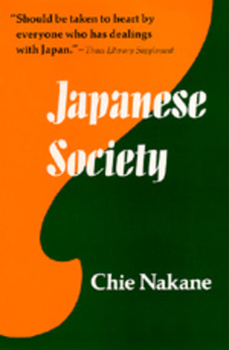Japanese Society: Volume 4
(Part of the Center for Japanese Studies, UC Berkeley Series)
Select Format
Select Condition 
Book Overview
This short work presents a configuration of the important elements to be found in contemporary Japanese social life, and attempts to shed new light on Japanese society. Nakane deals with his own society as a social anthropologist using some of the methods which he was accustomed to applying in examining any other society. However, its form is not that of a scientific thesis (as may be seen at once from the absence of a bibliography; the author also refrains from quoting any statistical figures or precise data directly obtained from field surveys). Nakane has tried to construct a structural image of Japanese society, synthesizing the major distinguishing features to be found in Japanese life. He has drawn evidence almost at random from a number of different types of community to be found in Japan today--industrial enterprises, government organizations, educational institutions, intellectual groups, religious communities, political parties, village communities, individual household and so on. Throughout this investigation of groups in such varied fields, Nakane has concentrated my analysis on individual behavior and interpersonal relations which provide the base of both the group organization and the structural tendencies dominating in the development of a group.
Format:Paperback
Language:English
ISBN:0520021541
ISBN13:9780520021549
Release Date:February 1972
Publisher:University of California Press
Length:170 Pages
Weight:0.50 lbs.
Dimensions:0.5" x 5.5" x 8.2"
Customer Reviews
5 ratings
Japanese society in a nutshell
Published by Thriftbooks.com User , 19 years ago
Nakane's description of hierarchy where workers in the same company from the vice-president down to assembly men have more in common than with their counterparts in other companies was extremely useful to me in writing my own book on Japan. Her descriptions of how seniority in groups is formed is extremely useful in understanding Japanese society as well. This short book is a must-read for the plane. All business people, Japan Exchange and Teaching participants, expatriates, and high school and college exchange students should read the book before, during, and after their stay in Japan.
A Classic
Published by Thriftbooks.com User , 19 years ago
For many years now any list of must-read books for the aspiring student of modern Japan has included Ruth Benedict's Chrysanthemum & The Sword, which popularized the notion of Japan being a shame-based culture, and Chie Nakane's Japanese Society which explored the notion of Japan being a "vertical society", and though it is has been more than 30 years since Japanese Society was first published it is still a valuable introduction to how Japanese interact with each other. Nakane is a social anthropologist, and her analysis focuses on both the group structure and the vertical nature of Japan's society - in Japan your identity is based on what group you belong to, and your position within its hierarchy, what she refers to as "frame", rather than any individual "attributes" you may have. Using examples from assorted groups: companies, schools, political parties, associations of intellectuals, etc., she illustrates the dynamics of relationships within groups and also between groups, including the sometimes fierce competition that pervades inter-group rivalries, noting when the Japanese group dynamic increases efficiency of a group's aims, or decreases it. She makes comparisons with other societies, notably the U.S.A. and the Hindu caste system. As she says in her conclusion, Japan has undergone some drastic changes in the past 200 years, but the nature of social relations has stayed fundamentally the same. Her conclusion also gives a good explanation why democracy has a subtly different meaning in Japan than in western nations and why revolution is impossible in Japan. That Japan is a group-oriented and vertical society is well known, but reading this slim volume will show you some of the more subtle ways it operates and help you understand the pressures that constrain Japanese people in their daily lives.
If you would seek to understand Japan, read this book.
Published by Thriftbooks.com User , 22 years ago
While no book can give you full understanding of culture, Japanese Society opens the door to understanding. The style, while academic, is clear and accessible. The book is concise and informative. Anime and manga fans, as well as Japanophiles, will find that this text clears up a lot of the strange interactions to be found in popular Japanese culture.
A long-selling book
Published by Thriftbooks.com User , 24 years ago
This book is a long-selling book and can be found in almost any local bookstore in Japan. The contents are worth reading for many Japanese, not only for those interested in an introduction to Japanese society and education. I believe that many Japanese are hoping that the systems and structures change and thus a book like this has become a best seller.
Great for any foreiner wanting to understand the Japanese.
Published by Thriftbooks.com User , 25 years ago
I found this book an invaluable source of information about the intricacies of Japanese society. A must for anyone who wants to live in Japan or work with the Japanese. Nakane Chie provides an inside look into the way of thinking that permeates Japanese society. A must for any foreigner.





